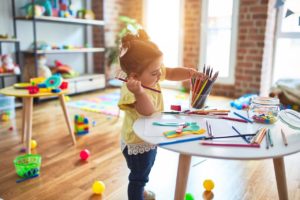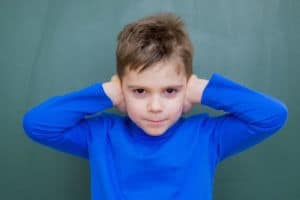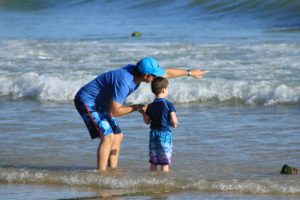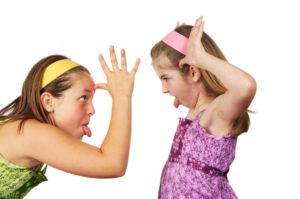Maria Montessori wasde was born in 1870 and was the first woman to graduate with an academic degree in Italy. After earning a doctorate in medicine, she took a job in a psychiatric hospital. There she worked with handicapped children. They were hardly employed at that time. Support programs or special educational methods for disabled children did not exist. Doctors Seguin and Itard began to produce learning materials for these children. Because of the success of these methods, Maria Montessori wondered if they could be used to help healthy children.
A little later Maria Montessori began to study philosophy. At the same time, she intensively studied educational and psychological articles.
Based on her previous experiences, observations of learning children and what she had learned through her studies, she developed an educational concept. With a variety of materials suitable for children, she not only aroused their interest, but was able to positively influence their learning progress.

Finally, she opened a children’s house for children between the ages of three and six. The house “San Lorenzo” was located in a poor district of Rome. Up until 1951, she herself held numerous courses in which she taught her pedagogical knowledge.
Table of contents
Phases Of Development According To Montessori
Maria Montessori approached the child with a holistic view. She did not separate personality development, social development and the ability to cognitive learning processes. Her concept is aimed at toddlers, elementary school children as well as adolescents alike.
- Also interesting:
- The best Montessori material
- Recommended motor cubes for children
- The 8 best sewing machines
Montessori assumed that children unconsciously strive for independence. They want to break away from adults and discover the world on their own. Out of this striving, the child continually develops. Because the child feels the urge to learn to walk, at some point it makes its first attempts to stand on its own two feet. It is the same – according to Montessori – with cognitive learning processes from primary school age.
Although children want to be independent, they are defacto still dependent on the adult. This is reflected in the well-known saying “Help me to do it myself!”. On the one hand, the child needs someone to show him how to do something. On the other hand, it strives on its own to learn new things and to grow up. Because the child wants to learn by itself, it does not need to be exposed to pressure or coercion.
Montessori assumed that children have very individual learning speeds. She therefore demanded that children work independently on those tasks that they choose. In this way, the child becomes the creator of his or her own curriculum. Everything happens at the time that suits the child, without having to force it.
This prevents learning blockades and lengthy arguments between educator and child. Each phase of development according to Montessori is characterized by certain “sensitive phases” in which the child is receptive to certain learning processes. According to Montessori, we adults must not demand certain learning goals at set times that are the same for everyone. Rather, each child shows readiness for a developmental step at an individually different time by expressing interest in it or specifically reaching for appropriate learning materials.
In Montessori education, the following developmental stages are distinguished:
The Absorbent Mind (Between 0 And 3 Years)
During the first three years, the foundation for more complex learning is laid. His personality also develops depending on how and what the child experiences during this time. By “absorbent mind,” Montessori means the child’s striving, ne to absorb new knowledge. It is essentially different from the adult because it absorbs and stores impressions without having to understand them from the ground up. In the first years of the child’s life, the sensitive phase for order takes place. The child looks for the constancy of things in order to be able to orientate itself by them. It needs an order that gives it security.
Unconscious Worker (Between 3 And 6 Years)
During the following three years, the child also tries to take in new things and get as many impressions as possible. However, from the third year on, the child begins to become more impressionable. During this time, the child has a sensitive phase for language skills. It begins long before the child speaks for the first time. At around five years of age, the child is able to break down language into its details.
Orientation To The Outside World (6 To 12 Years)
During this period, the child is in a phase of growth. At the same time, he or she is psychologically and physically relatively stable. Now he wants to understand more about why and how things work in our world. In addition, it is interested in learning how to behave properly in certain situations. Abstract relationships are increasingly understood.
Society (13 To 15 Or 15 To 18 Years)
This final stage brings many changes. The child matures completely, although his character is not yet fully established. Therefore, the child is not infrequently dominated by doubts and insecurity. Some children are discouraged during this time and learn nun somewhat more difficult. This was later confirmed by neuropsychological studies.
In addition to decreased intellectual-psychological performance, health is also less than stable during this time. Peers gain importance, as do intense friendship relationships. With the entry into professional life, the adolescent begins to see himself as a part of society. He seeks out tasks for which he feels suited. Montessori had an apt comparison for the sensitive phase of social orientation in the group: the adolescent at this time is like a crab that has shed its old shell. Now he has new potential, but in the first time he is still vulnerable and sensitive. Children remain vulnerable for a while at this age, although they often behave as if the opposite were true.
Modern Montessori Education
Montessori laid the foundation for today’s Montessori education long ago. It is used in numerous kindergartens and schools today. For the most part, the methodology in such alternative educational institutions is based on thengs still based on Montessori’s insights and principles.
The following areas are given special importance in Montessori education today:
Freedom And Its Place In Childhood
Only behaviors that harm other children or are generally considered unkind are to be discouraged. All other expressions are allowed and should be closely observed by the educator.
In Montessori education, the child is free in its actions. It is allowed to be completely itself. This is expressed in the freedom to express their feelings. It is also allowed to decide when it wants to learn what. This freedom is only limited to the extent that the well-being of other people may not be endangered by the child. However, it is completely normal for children to come up against these limits again and again. Over time, it learns to assess and respect these limits.
Preparation Of The Learning Environment
Montessori placed great emphasis on the fact that the prepared learning environment, rather than the method of education, should be the primary focus. This learning environment must be conducive to the child’s development. Moreover, it should be possible for him to develop freely in it – but guided if he wishes.
The prepared learning environment is accompanied by an abundance of materials, most of which still look the same today as they did in Montessori’s time. They are divided into five areas:
- Exercises of daily living
- Sensory material
- Mathematics material
- Language material
- Cosmic education material
The learning material is simple, but still has a strong appeal. The best example of the aesthetics of these media is the golden bead material for teaching mathematics. If one carries out the exercises with the child as Montessori intended, the child can always concentrate on a specific task. A particular skill is thus trained. This makes it quite easy for the educator to find out misunderstandings and work on them together with the child. This in turn prevents frustration and keeps the child motivated.
Because the child should always work as independently as possible, Montessori material always includes a possibility for self-control. This makes it ideally suited for independent work – alone or in groups.
The Role Of The Educator
Before the learning facilitator goes to work, he should be aware of the following: Respect for the child as a small human being who wants to develop himself is paramount.
If the child is balanced and independent, then constant confirmation by the adult is not necessary. However, it does need the opportunity to orient itself to adults. The behavior of adult companions should remain comprehensible and predictable for the child.
Hierarchical structures also exist in Montessori lessons. The adult is an authority figure who is aware of the child’s need for freedom and development. He may only intervene in the child’s life world to the extent that the child may continue to rely on himself and act according to his own feelings.
If certain limits are not observed, the adult does intervene. For example, if aggressive behavior endangers the well-being of other children. In addition, the children should not be disturbed while working – the adult is also responsible for this.
The adult is also responsible for the materials and their preparation. He introduces the children to the materials and enables them to work with them independently. Like a “flame […] whose warmth activates, makes alive and invites…” (Montessori, 1994, p.59), it motivates the children.
Whether teacher or parent, the adult must always relinquish some control. If a child is interested in an exercise, although one would rather have the child occupied with something else, one must not disturb it. Especially not when the child is concentrating intensively on an exercise. Consequently, you should refrain from making comments when the child is trying to do an exercise. Sometimes it takes a few attempts until the child masters the exercise on its own and gets the hang of it. The greater the learning success, the aha experience will be. If one wants to educate according to Montessori’s approaches, one should therefore bring along some patience and be prepared to bite one’s lips now and then instead of wanting to control the children.
This principle is also logical in itself, considering the fragile concentration of the children. If it becomes unsettled, it may not find its way back into its thinking process and feel discouraged.
Critical View Of The Montessori Concept
Maria Montessori was a pioneer of alternative ways of thinking about teaching. Many of her approaches remain relevant today. On the other hand, there are situations in which they clearly seem outdated.
Different Circumstances Prevail Today
Of course, children have changed since Montessori’s time. Teachers, especially in compulsory schools, face entirely new challenges that Montessori did not yet know. Therefore, her principles are not to be regarded today as dogma to be followed blindly. Depending on which children are in a class, sometimes a certain teacher presence is always needed.
Integration In Regular Classes: Not Always Easy
It is laudable to use Montessori’s approaches and principles in regular classes. But this idea makes only limited sense. Because at Montessori schools children have learned from an early age to work independently on themselves. They are used tothat the teacher hardly interferes in their learning. To expect this independence from a child who has been educated differently is rarely purposeful.
If you want to incorporate parts of the concept into your own teaching or educational style, then you should always keep this difficulty in mind.
Play Material Vs. Learning Material
One point of criticism from many educators has to do with the learning material. To this day, the principle in Montessori education is that materials are not to be played with. They are to be used and regarded as learning and working material. Precisely because the material is kept simple, children are often tempted to “misuse” it. Although it would be beneficial to the child’s imagination, they are not allowed, for example, to use the length bars in play as trains and cars.
The theme Imagination is generally a point of criticism here. Montessori, for example, saw these as insufficient experiences of reality. If the child had a better relation to the object car, then he would not use the length rod as such.
Regarding artistic education, Montessori says, among other things: “The child paints a horse green only because he has not yet seen one exactly.”
Developmental Issues
The age of reading and writing is somewhat advanced in Maria Montessori’s work – compared to the classical education of today. It remains questionable whether this makes sense in light of the child’s overall development.
Furthermore, Montessori did promote the individuality of the child. However, according to critical voices, social relationships are not sufficiently taken into account.
In view of the group work culture in modern regular school classes, Maria Montessori could also be chalked up to the fact that individual work plays a major role in her methodology. Just like educational styles per se, teaching principles are subject to constant change, which goes hand in hand with the constant change of societal values from generation to generation. Seen in this light, Montessori education certainly has its drawbacks. Nevertheless, Maria Montessori was far ahead of her time at the time, and to this day has become an inspiration to educators for whom the usual mainstream education is not enough.












